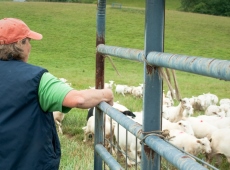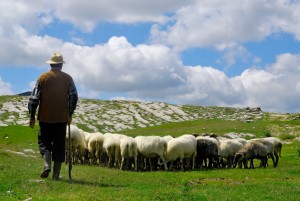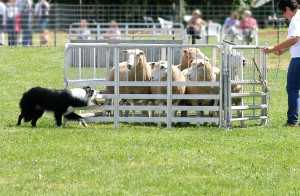Shepherding

Good shepherding skills are of paramount importance in all sheep systems. At its most basic, all shepherds should be aware of the welfare needs of their sheep and be capable of safeguarding them under all foreseeable conditions. The size of a flock and the stocking rate and/or housing density should not only depend on the suitability of the environment and the capacity of the farm but also the competence of the shepherd and the time available to carry out his or her duties.
A stockperson should be a care-taker responsible for nutrition and health as well as handling and husbandry. Observation, interpretation and action are three essential components of being a stockperson (Hargreaves and Hutson, 1990). It is important to ensure that enough time is available within a normal work routine for the flock to be properly inspected and for any necessary remedial action to be taken. Extra help is probably necessary during key periods, and in particularly during lambing, veterinary treatments and at shearing, although in some extensive systems, human intervention is not always beneficial (Fisher and Mellor, 2002).
Recognising Health Indicators
Shepherds should know the signs of both good and poor health:
| Indicators of good health | Indicators of poor health |
| General alertness, free movement, active feeding and rumination, absence of lameness, visible wounds, abscesses or injuries. | Listlessness, abnormal posture and behaviour, lameness, scouring, absence of cudding, persistent coughing or panting, scratching and frequent rubbing, rapid loss of body condition, excessive wool loss, sudden fall in milk yield and, in some circumstances, being apart from the flock. |
Defra, 2003
Understanding Behaviour
Understanding the behaviour of sheep is key to successful shepherding and care-taking, and most importantly, enabling a flock and the individuals within that flock to meet their basic behavioural needs. For example, sheep behaviour should be the primary consideration when designing a handling system and is a factor determining how effective the system is i.e. how well does the system accommodate and exploit the animals’ behaviour (Hargreaves and Hutson, 1997).
The two most obvious behavioural features of sheep that we exploit when animals are moved through handling facilities are that of following other sheep and flocking together in a group. However, these social behaviours can also cause problems when individuals need to be separated from the rest of the flock.
Flocking Behaviour
The social environment, or the immediate physical and social setting that sheep live, is determined by the flock size, composition and density. So what constitutes a flock? Sheep are a highly social species and five sheep can be considered as the smallest grouping that enables the group to exhibit flock behaviour (Crofton, 1958 cited by Hargreaves and Hutson, 1997). They can get very stressed when isolated, even when they are in ear-shot of others (Price and Thos, 1980; Parrott et al., 1990; Cockram et al., 1994).
Flocking behaviour and the bond between sheep in flocks are important traits that need to be considered, particularly when handling and moving sheep. The appears to be a breed difference with regard to the extent of the bond formation (Arnold and Pahl, 1974), although the strongest bond is between mother and offspring which can last for a number of years (Hinch et al., 1990).
Hierarchies within a flock tend not to be important at grazing but are more evident in housed sheep. Dominance in a flock is closely correlated with bodyweight and height and dominant animals within a flock are not necessarily leaders but position themselves away from other dominant individuals and humans (Dove et al., 1994).
Sheep can use facial cues to discriminate between different species, breeds and male and female members of the same breed. They are able to recognise distinguishing features (such as horns) as well as recognising preferred individuals (socially familiar animals) and potentially threatening individuals (humans and sheep dogs) (Kendrick, 1991; Kendrick et al., 1995).
Human-animal Interactions
Contact with humans generally results in an alarm or stress, and the extent of this is dependent on the behaviour and actions of the human as well as the frequency of contact. Crowding, and particularly with unfamiliar sheep, can be stressful. The effect of driving a flock by a shepherd and dog can result in a large increase in heart rate indicative of extreme stress (Baldock and Sibly, 1990). Human contact at critical times can also disrupt reproduction and maternal behaviour.
There are breed differences in the way sheep respond to humans. Breeds that are easily moved in flocks tend to be more difficult to physically restrain (Whateley et al., 1974).
It is possible to condition sheep to certain handling procedures. They quickly learn to avoid negative handling experiences (Rushen, 1986) and seek out positive stimuli, for example if food is offered after handling (Hutson, 1985). Familiarisation through frequent exposure to the handling facilities can have slight improvements in the animals’ response to handling (Hargreaves and Hutson, 1990). Sheep remember these negative and positive learned responses for long periods, sometimes years. It is also possible to train ‘leader’ sheep to, for example, use handling facilities (Bremner et al., 1980), which encourages others to follow. More on Handling
At lambing time, human interactions and the response of the sheep to human presence, will be particularly important for sheep welfare (Goddard et al., 2006) although not always so in extensive systems (Fisher and Mellor, 2002). See Breeding and Lambing for more.
Brief gentle contacts with handlers can improve the approachability of sheep (Mateo et al., 1991).
Moving Sheep
The notion of a flight zone applies to both groups of animals and to individuals. Animals in groups are more approachable and therefore have a shorter flight distance. Understanding and sensitivity to the flight zone of animals can assist the stockperson to catch individual sheep. It has been shown that analysis of head orientation in relation to an approaching human can provide a useful predictor of flight distance. On the edge of the flight zone approximately half the flock will be facing towards the handler and half facing away (Hutson, 1982). The flight distance is reduced when the approach is rapid and when sheep are more closely confined.
Movement of flocks or individual sheep by humans or dogs occurs when the flight zone is penetrated causing the animal to move away (Grandin, 1980). Successfully moving sheep in a particular direction, without causing stress and dispersion, is best achieved by utilising two notional ‘points of balance’ on the animal (cited by Hargreaves and Hutson, 1997). Forcing the animal from the point behind the shoulder causes the animal to move forward and vice versa. Moving the animal left or right can be achieved by moving either side of the point between the eyes.
More on the Flight Zone in the Cattle Management page but also please visit Understanding Flight Zone and Point of Balance for Low Stress Handling of Cattle, Sheep, and Pigs
Overcoming Handling Stress
Three possible approaches might be taken to reduce the negative experience of being handled:
• Making the treatment less severe
• Changing the sheep’s perception of the treatment or
• Breaking the link between being handled and receiving a negative treatment (Hargreaves and Hutson, 1997).
It is possible to reduce stress by taking advantage of the learning capacity of sheep by encouraging habituation to stressful events, gentle handling during early critical periods, or training leader sheep (see Human-Animal Interactions above). The success of habituation will depend on the number and frequency of exposures to the handling treatment, which reduces the possibilities of such an approach in extensive systems (Goddard et al., 2006).
Further Reading
Further information on handling sheep can be found at http://www.sheep101.info/201/handling.html
How to handle & restrain sheep, a booklet from Alberta SPCA
An Introduction to Sheep Handling and Behaviour factsheet is supplied by the Saskatchewan Ministry of Agriculture


 American English
American English



Comments are closed.